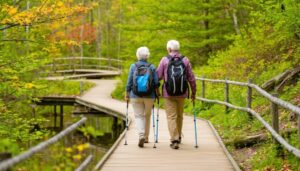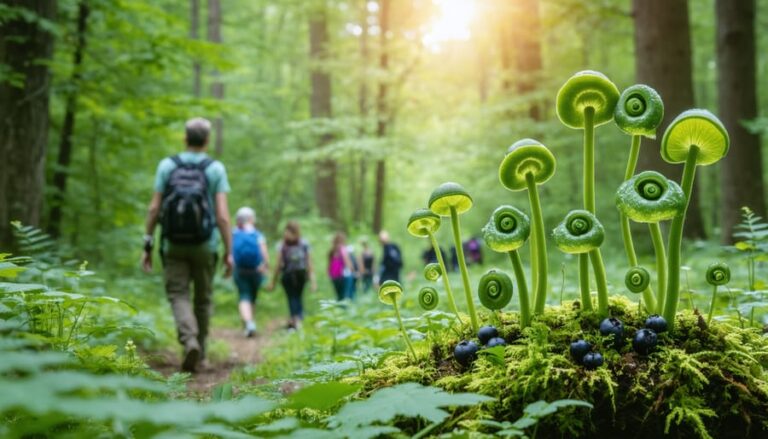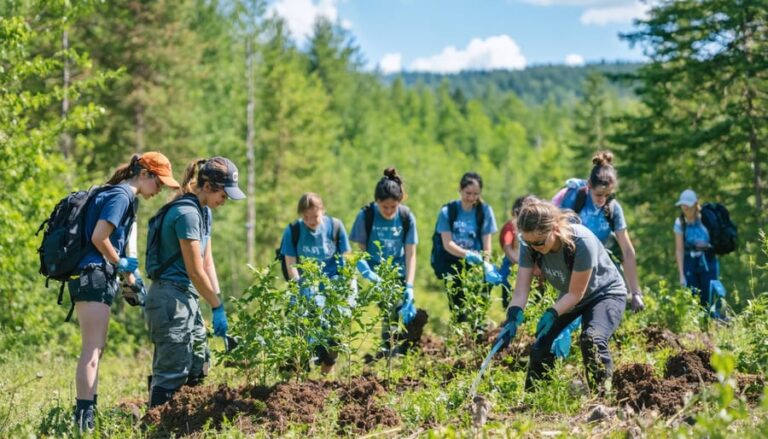Transform your daily walk into a soul-soothing nature experience by discovering the edible treasures hiding in plain sight throughout Ontario’s parks. From tender spring fiddleheads to sweet autumn berries, our local parks offer a living classroom for natural nutrition enthusiasts. Learn to identify safe, nutritious plants while connecting with the rhythms of traditional foraging practices that have sustained generations of indigenous communities. Whether you’re a curious beginner or an experienced forager, Ontario’s diverse park system provides the perfect environment to explore the intersection of outdoor recreation and natural nutrition. Join certified guides on educational walks, discover seasonal eating patterns, and develop a deeper appreciation for the botanical abundance that surrounds us. This guide will help you safely navigate the world of wild edibles while respecting park regulations and preserving these precious natural resources for future generations.
What Makes Ontario Parks Perfect for Nutrition Walks
Seasonal Edible Plants in Ontario Parks
Ontario’s parks offer a treasure trove of edible plants throughout the year, making them perfect destinations for seasonal natural wellness activities. In spring, look for wild leeks (ramps) and fiddleheads emerging from the forest floor, offering delicious and nutrient-rich additions to your meals. Summer brings an abundance of wild berries, including strawberries, raspberries, and blackberries, perfect for trail snacking.
As autumn approaches, keep an eye out for wild mushrooms like chanterelles and puffballs – though always forage with an experienced guide. You’ll also find nutritious nuts like black walnuts and hickory nuts scattered along park trails. Even winter offers treats like rose hips and birch tea, though harvesting becomes more limited.
Remember to follow park guidelines and never harvest endangered species. A good rule of thumb is to take only what you need and leave plenty for wildlife and other foragers. Pro tip: join a local foraging group or guided tour to learn proper identification and sustainable harvesting practices. These outings are fantastic ways to connect with nature while discovering the edible treasures hiding in plain sight.

Best Parks for Nutrition Walks
Ontario’s parks offer incredible opportunities for nutrition-focused walks, with several standout locations known for their rich biodiversity and educational programs. Algonquin Provincial Park leads the pack with its well-marked trails featuring edible wild berries and mushrooms, plus regular guided foraging walks during summer months.
Rouge National Urban Park in Toronto provides an accessible option for city dwellers, offering scheduled “Wild Edibles Tours” where participants learn about indigenous plants and their nutritional benefits. The park’s diverse ecosystem includes numerous medicinal plants and seasonal fruits.
Bruce Peninsula National Park stands out for its unique mix of forest and shoreline vegetation, featuring guided programs that explore both traditional Indigenous food plants and modern foraging practices. The park’s interpretation center offers seasonal workshops on sustainable harvesting and plant identification.
Don’t miss High Park in Toronto, particularly during spring when their nature center hosts “Foraging 101” walks. The park’s extensive oak savannah contains numerous edible species, and their knowledgeable staff provide excellent guidance for beginners interested in natural nutrition.
Remember to always participate in guided programs rather than foraging independently, as this ensures both safety and environmental preservation.
Planning Your Holistic Nutrition Walk
Essential Safety Guidelines
While foraging in Ontario’s parks can be an enriching experience, safety should always come first. Before you begin, ensure you have proper identification guides and never consume any plant unless you’re 100% certain of its identity. It’s best to start with guided tours or workshops to learn from experienced foragers.
Always check local regulations and obtain necessary permits before foraging. Many parks have specific rules about what can be collected and in what quantities. Remember to harvest sustainably by taking only what you need and leaving enough for wildlife and plant regeneration.
Keep these essential safety tips in mind:
– Stay on marked trails to avoid harmful plants like poison ivy
– Avoid foraging near roads or areas that may have been treated with pesticides
– Bring clean containers for collection and wear appropriate clothing
– Carry a first-aid kit and plenty of water
– Let someone know your plans and expected return time
– Never harvest mushrooms without expert guidance
– Wash all foraged items thoroughly before consumption
Be mindful of protected species and areas within parks. Some plants may look similar to edible varieties but could be toxic. When in doubt, take photos instead of samples and consult with local experts. Remember that foraging should enhance nature’s beauty, not damage it.
What to Bring
Before heading out on your nutrition walk, pack these essential items to ensure a safe and enriching experience. Start with a sturdy backpack containing at least two reusable water bottles to stay hydrated. Pack healthy snacks like trail mix, dried fruits, and energy bars for sustained energy during your walk.
Essential equipment includes a plant identification guide or reliable mobile app (download offline versions), a small notebook and pen for taking notes, and a camera to document interesting finds. Bring several small cloth bags or containers for collecting edible plants (where permitted), and always carry a basic first-aid kit.
Dress appropriately with comfortable, weather-resistant hiking shoes and layered clothing. Don’t forget sun protection: a hat, sunscreen, and sunglasses are must-haves. Bug spray and hand sanitizer will also come in handy.
For serious foragers, consider bringing:
– A small pair of scissors or pruning shears
– Clean garden gloves
– A pocket knife (check park regulations first)
– Mesh bags for mushrooms
– A magnifying glass for plant identification
Remember to pack a map of the park and fully charge your phone before departure. Consider bringing a portable charger for longer excursions. If you’re joining a guided tour, check with your instructor for any additional required materials or tools specific to the program.
Pro tip: Keep a dedicated “nutrition walk kit” packed and ready to go – it makes spontaneous park visits much easier!

Connecting with Nature’s Pantry
Common Nutritious Plants to Look For
Ontario’s parks are treasure troves of nutritious plants that are both safe and delicious when properly identified. One of the most common edibles you’ll spot is the dandelion – every part is edible, from its bright yellow flowers to its nutrient-rich leaves, which are packed with vitamins A, C, and K.
In spring and early summer, keep an eye out for wild leeks (also known as ramps) carpeting the forest floor. These flavourful plants offer a wonderful garlic-onion taste and are rich in vitamins and minerals. Just remember to harvest sustainably by taking only one leaf per plant.
Lamb’s quarters, often dismissed as a common weed, is actually a superfood containing more iron than spinach. You’ll frequently find it growing along trail edges and in sunny clearings. Its distinctive dusty-blue-green leaves are easy to spot and have a mild, spinach-like taste.
Wild berries are another nutritious find in Ontario parks. Blackberries and raspberries are easily identifiable and typically ripen in late summer. They’re excellent sources of antioxidants and vitamin C. Look for them along sunny trail edges and in forest clearings.
Always remember these essential foraging rules: never harvest plants from protected areas, be 100% certain of your identification before consuming any wild plant, and only take what you need. It’s best to join a guided foraging walk with an experienced naturalist for your first few outings to build confidence in plant identification and learn about sustainable harvesting practices.
Note: Be especially careful with mushrooms, as many edible varieties have toxic look-alikes. Stick to easily identifiable plants when starting out.
Mindful Walking and Plant Appreciation
Taking a mindful approach to exploring park nutrition can transform a simple walk into a profound connection with nature’s edible offerings. Mindful nature walking allows you to notice subtle details you might otherwise miss – the gentle unfurling of fiddleheads in spring, the sweet scent of wild berries in summer, or the earthy aroma of mushrooms after rainfall.
Start by slowing down your pace and focusing on your breath. Notice how your feet connect with the earth beneath you. As you walk, engage all your senses. Look for different shades of green in edible plants, listen to the rustling leaves, and feel various textures of bark and leaves. This heightened awareness not only reduces stress but also helps you become a better plant observer and forager.
Try the “stop and spot” technique: every few minutes, pause and scan your surroundings. Look up at the canopy for nuts, down at the forest floor for mushrooms, and at eye level for berries and edible flowers. Take notes or photos of interesting plants you encounter, but remember to maintain a respectful distance from any species you’re not completely sure about.
Consider keeping a nature journal to document your observations, including sketches of plants, their locations, and the seasons you spotted them. This practice deepens your connection with the park’s natural abundance while creating a valuable personal reference for future visits.
Remember to practice gratitude for the nourishment these parks provide, and always follow local guidelines for sustainable foraging. The more mindfully you explore, the richer your park nutrition experience becomes.
Learning Opportunities and Guided Experiences

Park Naturalist Programs
Ontario’s provincial parks offer fascinating naturalist-led programs that connect visitors with the nutritional bounty of our natural landscapes. These expert-guided experiences blend education with hands-on exploration, teaching participants about edible plants, traditional Indigenous food sources, and the therapeutic benefits of park gardens.
Popular programs include “Wild Edibles Walks,” where certified naturalists guide small groups through park trails, identifying safe-to-eat plants and sharing preparation tips. The “Forest to Table” workshops, offered seasonally, teach participants about sustainable foraging practices while exploring the nutritional value of common park flora.
Many parks also feature dedicated educational gardens where visitors can learn about native food plants and their historical significance. These living classrooms showcase everything from traditional medicinal herbs to contemporary sustainable farming practices.
For families, the “Junior Naturalist” program offers kid-friendly activities focused on natural nutrition. Children learn through interactive games and crafts, discovering how local wildlife finds nourishment in different seasons.
To participate in these programs, simply check your chosen park’s event calendar or visit the park office upon arrival. Most programs run from spring through fall, with special winter sessions focusing on cold-weather foraging and preservation techniques. Remember to book early, as these popular programs often fill up quickly!
Local Nutrition Experts and Groups
Ontario’s parks and natural spaces are home to numerous nutrition experts and community groups dedicated to sharing their knowledge of wild edibles and natural nutrition. The Ontario Nature Network connects enthusiasts with certified naturalists who lead educational foraging walks and workshops throughout the province’s park systems.
The Wild Ontario Food Collective, based in Toronto but active across the province, organizes regular meetups in various parks where members can learn about seasonal edibles from experienced guides. They also maintain an active online community where participants share discoveries and arrange group outings.
Local Indigenous communities often partner with parks to offer traditional food knowledge programs. These invaluable sessions provide insights into historically significant plants and sustainable harvesting practices that have been passed down through generations.
For those interested in formal education, several Ontario universities and colleges offer certificate programs in natural nutrition and wild edible identification. These programs often include practical components in local parks and conservation areas.
Many regional conservation authorities host regular workshops on park nutrition, connecting participants with qualified botanists and nutrition experts. The Bruce Trail Conservancy, for instance, regularly organizes guided walks focusing on identifying edible plants along their extensive trail system.
Don’t forget to check your local community centers and libraries, as they frequently partner with nature educators to offer introductory courses on park foraging and natural nutrition.
Embarking on nutrition walks through Ontario’s magnificent parks offers an unparalleled opportunity to connect with nature while learning about the incredible edible bounty around us. These experiences not only enhance our understanding of natural food sources but also provide a unique way to stay active and engaged with the environment.
By participating in guided nutrition walks or exploring independently with proper knowledge, you’ll discover a whole new dimension to your park visits. From identifying seasonal berries to learning about traditional Indigenous food plants, each adventure brings fresh insights into sustainable living and natural nutrition.
The benefits extend far beyond the educational aspect. These walks provide excellent exercise, stress relief, and a chance to bond with family and friends while developing a deeper appreciation for our local ecosystems. They also encourage environmental stewardship by helping us understand the delicate balance between harvesting and conservation.
We encourage you to take the first step in your nutrition walk journey. Start with a guided tour at your nearest provincial park, join a local foraging group, or simply begin observing the edible plants in your area. Remember to always prioritize safety, respect park regulations, and practice sustainable harvesting techniques.
As you explore Ontario’s diverse parks, you’ll find that each season brings its own unique nutritional treasures, making every visit a new opportunity for discovery and learning. Get out there and experience the natural abundance our parks have to offer!














+ There are no comments
Add yours